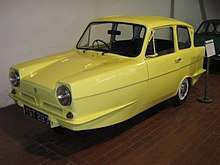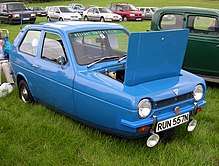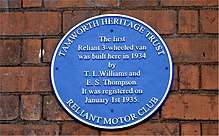Reliant Motors
 1971 Reliant Regal | |
| Industry | Automotive |
|---|---|
| Fate | Finishing of production |
| Founded | 1935 |
| Defunct | 2002 |
| Headquarters | Tamworth, England |
Key people |
T L Williams, co-founder E S Thompson, co-founder |
| Products | Automobiles |
| Website |
www |
Reliant was a British car manufacturer, traditionally based at Tamworth in Staffordshire, England.
Reliant was best known for the 3-wheeled Reliant Robin, but produced a variety of vehicles over 60 years, including popular sports cars, convertibles and commercial vehicles. Around half a million Reliant vehicles were produced, and were sold in at least nine countries.
The only part of Reliant Motor Company LTD that still operates is Reliant partsworld, which produces spares for Reliant vehicles.
History

When the Raleigh Bicycle Company decided to discontinue the manufacture of their three-wheeled vehicles in 1934, their Works Manager T. L. Williams and a colleague, E. S. Thompson, felt that the days of lightweight three-wheelers were not over. They decided to build their own vehicle in Williams's back garden at Kettlebrook Road, Tamworth. The homebuilt design closely resembled the Karryall van previously built by Raleigh, and the prototype was licensed in January 1935.[1] It was a 7 cwt (356 kg) van with a steel chassis, powered by a 600 cc single-cylinder engine driving the rear wheels through a 3-speed gearbox and chain drive. The body was a hardwood frame with aluminium panels attached to it, in the manner of the time. With the motorcycle front end, mounted in the open, in front of the bulkhead, it was essentially a motorcycle fitted with a box body. The initial prototype had handlebars for steering[2] although after several trials with small local companies, this was changed for a steering wheel.
The work moved to a disused bus depot on Watling Street in Fazeley.[1] On 3 June 1935, the first Reliant was delivered. Powered by a single-cylinder air-cooled 600cc J.A.P. engine, the driver sat centrally on the vehicle astride the engine, much like a motorcyclist. The single-cylinder engine left the Reliant underpowered. In March 1936 a two-cylinder, water-cooled J.A.P. engine and an increase to 8 cwt (407 kg) gross vehicle weight (gvw) was released. The driver no longer sat astride the engine and the vehicle gained more conventional forward-facing seats in the front. The first improved 8cwt twin cylinder model was delivered on 16 March 1936.
In 1936, British finance minister Neville Chamberlain abolished (as it turned out, only temporarily) the "road fund licence", an annual car tax that had not been applied to three-wheelers and that had therefore conferred a major competitive advantage on Reliant's "three-wheeled motor goods vehicle".[1] This did not dissuade the engineers at Reliant.
.jpg)
In 1938 the Reliant Motor Company started to use the 747cc four-cylinder 7 hp Austin side-valve engine as found in the popular Austin Seven. The first four-cylinder Reliant was delivered on 12 March 1938. The Austin Car Company then announced their intention to cease production of the 747cc Austin Seven engine. Williams was always enthusiastic about making Reliant as self-reliant as possible. He was keen that the company did not buy parts that it could make 'in-house'. Austin sold all the 747cc engine tooling and manufacture rights to Reliant. Reliant therefore commenced to manufacture this engine. Although appearing very similar to the Austin engine, the level of commonality between Reliant and Austin remains unclear; the Reliant side-valve engine was a 747cc four-cylinder unit built using smaller-scale manufacturing techniques than Austin. The Reliant crankcase was sand-cast rather than die-cast.
During the Second World War Reliant machined parts for the war effort. In the post-war years, three-wheeler development continued. Reliant introduced a slightly modified van called the Regent. Visually similar to an oversized motorcycle, the first Regent was completed on 13 March 1946, ten years after the first twin-cylinder van.
The Regent grew to a GVW of 10 cwt and was better equipped with sliding windows in the doors, rather than canvas side screens. Two larger models were produced, a 12 cwt Regent and a Prince Regent. In 1953, the Regent continued to be built alongside the Reliant Regal. The Regent was eventually replaced by the Regal Mk II 5cwt van in 1956.
Car production
In 1952 a four-seat car was launched, initially with an aluminium body, but panel by panel the company substituted glass fibre, as the company's understanding of the material improved and the price of aluminium increased.[1] By 1956 the bodywork of the (by then) Mark 3 version of the Reliant Regal had changed completely to glass fibre, the first generation of vehicles were Mk1 to Mk6 with each one getting improvements and slightly different styling. The Regal Mark 1 to Mark 6 was powered by a 747cc Reliant side-valve engine 17.5 hp and were Reliant's last models to use their side-valve engine.
By 1963 the all new Regal 3/25 had its body completely made of fibreglass. On previous generations of the Regal the body was fibreglass, but the floor was made of hardwood that was bolted together. The engine was Europe's first mass-produced lightweight overhead valve aluminium alloy engine and the UK's first British overhead valve all-alloy engine, initially 598cc on the Regal 3/25 but later upgraded to 700cc on the later Regal 3/30.
At the same time Reliant were working for other countries to design vehicles for home-grown production. Vehicles would be sent over in kit form for the countries' own workforce to assemble. Reliant would first design the vehicle to the countries' or companies' requirements. The first was the Anadol in Turkey, which was based on a mix of Ford parts and a custom chassis. The Anadol began as a 2-door saloon, then a 4-door saloon, followed by commercial pickup and van versions. The pickup carried on production until the early 1990s.
Another vehicle of this sort of start was the Sabra also based on Ford running gear and engine. A 2-door coupe or convertible for Autocars Co. was designed for Israel. Reliant was so impressed with the design they sold it in the UK under the name Sabre, also to help Reliant's company image expand beyond a 3-wheeled micro-car maker. The car sold poorly against competitors such as Triumph and MG.
Later Reliant bought a prototype design for the replacement Daimler Dart which would later become the Scimitar Coupe and later would become the best-selling sporting estate – the Scimitar GTE.
To power the Scimitar GT Coupe and Sabre, Reliant turned towards Ford of Britain and were supplied with the Zephyr 6 and Consul 4 engines. The Coupe GT could be purchased with either the 2.5 litre or the 3.0 litre Essex V6 engines. Later, 3.0 GTE's were fitted with the "Essex" V6 engine and gearbox. On the 3.0 V6 GTE the back axle ratio changed depending on the use of either a straight 4-speed gearbox or one with an overdrive unit.
Reliant bought out Bond Cars in 1969 after Bond had gone into liquidation. Reliant purchased Bond after wanting to enter Triumph dealerships. Bond's equipe sports car already had this agreement, but sadly Triumph entered British Leyland and this deal ended. It is said that Bond was Reliant's main competitor in 3-wheeled vehicles with the Bond Minicar and the Bond 875, but Reliant vehicles outsold Bond in huge numbers with a much larger production and dealer network. Reliant did use the Bond name for the 1970s Bond Bug, which was a Reliant prototype originally named the Reliant Rogue, a sporty 3-wheeler designed by the Ogle designer Tom Karen. The Bug used a shortened Reliant Regal chassis and other mechanical parts, but many of the new parts such as the front swing arm were a brand new design that would also be used on the new Reliant Robin of 1973. The Bond Bug came in 700, 700E and 700ES models until replaced by the 750 model and production ended.
Reliant built 4-wheeled versions of their 3-wheeled stablemates – the original was called the Reliant Rebel, which had three-quarters of the rear chassis design of the Regal, but Triumph Herald front suspension and standard Austin Seven steering. The engines were the same 600cc and 700cc as the Regal but with higher compression and more torque because of the extra weight the Rebel carried over the Regal. The last model came with the 750cc version when the Mk1 Reliant Robin was introduced. The styling of the Rebel was intended to make the car look unique so it did not seem like a 4-wheeled version of the Regal; the Rebel came in saloon, estate and van models.
The Reliant Kitten was the 4-wheeled version of the 1970s Reliant Robin, designed to replace the Rebel and featuring the 850cc version of Reliant's own engine, which was introduced in 1975 (with the Reliant Robin gaining the engine shortly afterwards). The design this time featured very heavily on the Reliant Robin with only the nose of the design being different, having square headlights and a black panel around them – this was done mainly for cost-saving reasons so the parts from both vehicles could be shared for production.
After Reliant Kitten production stopped in 1982, the rights were sold to Sipani Automobiles in India who made the vehicle near-exactly the same, but with the name Sipani Dolphin. Later the vehicle became a 4-door hatchback called the Sipani Montana. The car was built well into the 1990s with exactly the same Kitten mechanicals. Reliant exported engines they had built for their own vehicles in the UK.
Between 1983 and 1990 a utility/pickup vehicle called the Reliant Fox was produced in the UK. This was based on an original development by Reliant to design a vehicle for the Greek company MEBEA. It was based on Reliant Kitten mechanicals with its own pick-up body and canvas top design. It had originally been built in Greece by MEBEA between 1979 and 1983.[3] After production finished in Greece, Reliant decided to build it in the UK, but gave the Fox many design changes, including 12-inch wheels, altered suspension and the high compression 850cc engine. They designed a rear hardtop to make the vehicle into a van or estate. Tandy Industries used Foxes as a basis for a compact, two-berth campervan.
Reliant also made a small 3-wheeled commercial vehicle called the Reliant TW9, later sold by other companies as the Ant (and, like the Robin, licence-built in Greece by MEBEA[3]), which was a chassis and cab, onto which a custom rear body was fitted: a road sweeper, a flat back, a van, a milk float and hydraulic lifting rear bed version were common fitments. Also as a fifth wheel (actually fourth wheel) articulated tractor unit was created to pull large trailers. It was often used by public utility companies or more commonly sold to councils, where its ability to negotiate narrow alleyways was a big advantage.
Reliant's expertise in the area of composite car body production also saw the company produce lightweight bodyshells for Ford RS200 rally cars and a glass fibre-bodied taxi, the MetroCab – the first to have full wheelchair provision, manufactured by a division of Kamkorp, they also made Ford fibreglass truck cabs and Ford Transit hightops.
With Reliant's expertise in glass fibre the company created bodies for trains, kitchen worktops and boat/jetski hulls.
Reliant's main business was selling 3-wheeled vehicles, largely to motorcyclists who did not wish to take the full car driving test; this was a sizeable niche market due to the large number of motorcyclists, and lasted until 2001 when Category B1 entitlement was no longer automatically granted to those who had passed their motorcycle driving test. Category B1 entitlement had previously permitted the holder to drive a 3 or 4-wheeled vehicle up to the weight of 550 kg); this removal effectively killed the market as new motorcyclists were no longer permitted to drive 3-wheelers.
End of car production
The Hodge Group bought the majority of Reliant in 1962, selling it 15 years later to the Nash family. During the early 1990s the owner of Reliant was a major housing developer and when the 1992 recession hit, the company folded and Reliant was sold to Beans Engineering. By 1996 Jonathan Heynes took the lead and his main backer took control – Heynes changed many models' design by employing designer Andy Plumb, and gave the Robin more luxuries and retro upgrades, doubling sales. Production was relocated to Plant Lane, Burntwood, in 1997 where, following a major redesign in 1998, Reliant built a whole new model of the Robin that featured all new panels and was essentially a 'heavy facelift'. Research continued into 4-wheeled Reliant models such as a Kitten for the modern age. Prototypes for this featured in many newspapers and magazines at the time. Production continued until 2001 when shareholders decided to import French Ligier micro-cars and Piaggio Ape 3-wheeler instead. Jonathon Heynes sold his shares and left the company before production ended because he wished to create an all new 4-wheeled Reliant model instead.
Final years
Reliant Motor Company produced 50 vehicles a week until 2001, when it finished production of its own models to focus on importing French microcars and motorcycles, as well as the Piaggio Ape range of commercial vehicles. A final version of the Reliant Robin was produced, with leather seats, metallic gold paint, alloy wheels, walnut dashboard, and some other luxurious features, which retailed for £10,000. The car was made in the company's 65th year of production, and so was named the Reliant Robin 65.
As well as the Reliant Robin, Reliant made many different three-wheeled models, such as the Rialto, TW9 and Regal, along with a line of small four-wheeled vehicles, including the Rebel, Kitten and Fox, and a range of Reliant sports cars.
Shortly after Reliant announced that production of the Robin would cease, production rights for the Reliant Robin were sold to a Sudbury-based firm called B&N Plastics, which redesigned major parts of the car. The cost of the base model, the BN-1 Robin, was £10,000, but had all the features of the Robin 65, such as a leather interior. A BN-2 model was produced, which added more luxury items as standard, including electric windows. With over 200 orders unfilled, B&N Plastics ceased production in late 2002, following an argument with Reliant over the supply of parts. B&N plastics also had to get type approval for the Robin, which cost £100,000 before production could start.
Reliant Cars Ltd. was renamed Reliant Partsworld, and operates from the factory where the Robin was built.
The old site of Reliant Motors, in Tamworth, was turned into a housing estate named Scimitar Park, after the Reliant Scimitar that the company produced. A number of streets in the estate were named after Reliant models as well, such as 'Robin Close'. The company produced up to two million vehicles over a 65-year history starting in 1935, and sold its cars in nine countries, including the Netherlands, India and the Middle East.
Blue plaque

On 8 July 2017, a blue plaque was unveiled to honour both of Reliant's founders, T. L. Williams and E. S. Thompson, and marked the birthplace of Reliant. The first Reliant prototype was built by Williams and Thompson in 1934, in the rear garden of Williams' residence named Bro-Dawel on the Kettlebrook Road in Tamworth.
Models
- 7cwt, 10cwt 1935–1939
- 8cwt, 10cwt, 12cwt 1946-1950
- Regent 1950–1956
- Regal 1953–1973 and Supervan III
- Sabre 1961–1964
- Scimitar GT 1964–1970
- Rebel 1964–1974
- FW5 1966–1975
- TW9 1967–1987
- Scimitar GTE/GTC 1968–1986
- Robin 1973–1982, 1989–2002
- Kitten 1975–1982
- FW11 1977
- Rialto 1982–1997
- Fox 1982–1990
- Scimitar SS1/SST 1984–1992
- Scimitar Sabre 1992–1995
See also
References
| Wikimedia Commons has media related to Reliant vehicles. |
Sources
- Pither, D (2001). Reliant Regal and Robin. Thrupp.
- Wotherspoon, N (1993). Lawrie Bond; the man and the marque. Minster Lovell.
- Armstrong, Aldridge, Boyes, Mustoe & Storey. Companion to British Road Haulage History. NMSI Trading Science Museum. ISBN 1-900747-46-4.
- Payne, Elvis (2016). The Reliant Motor Company. Crecy Publishing.